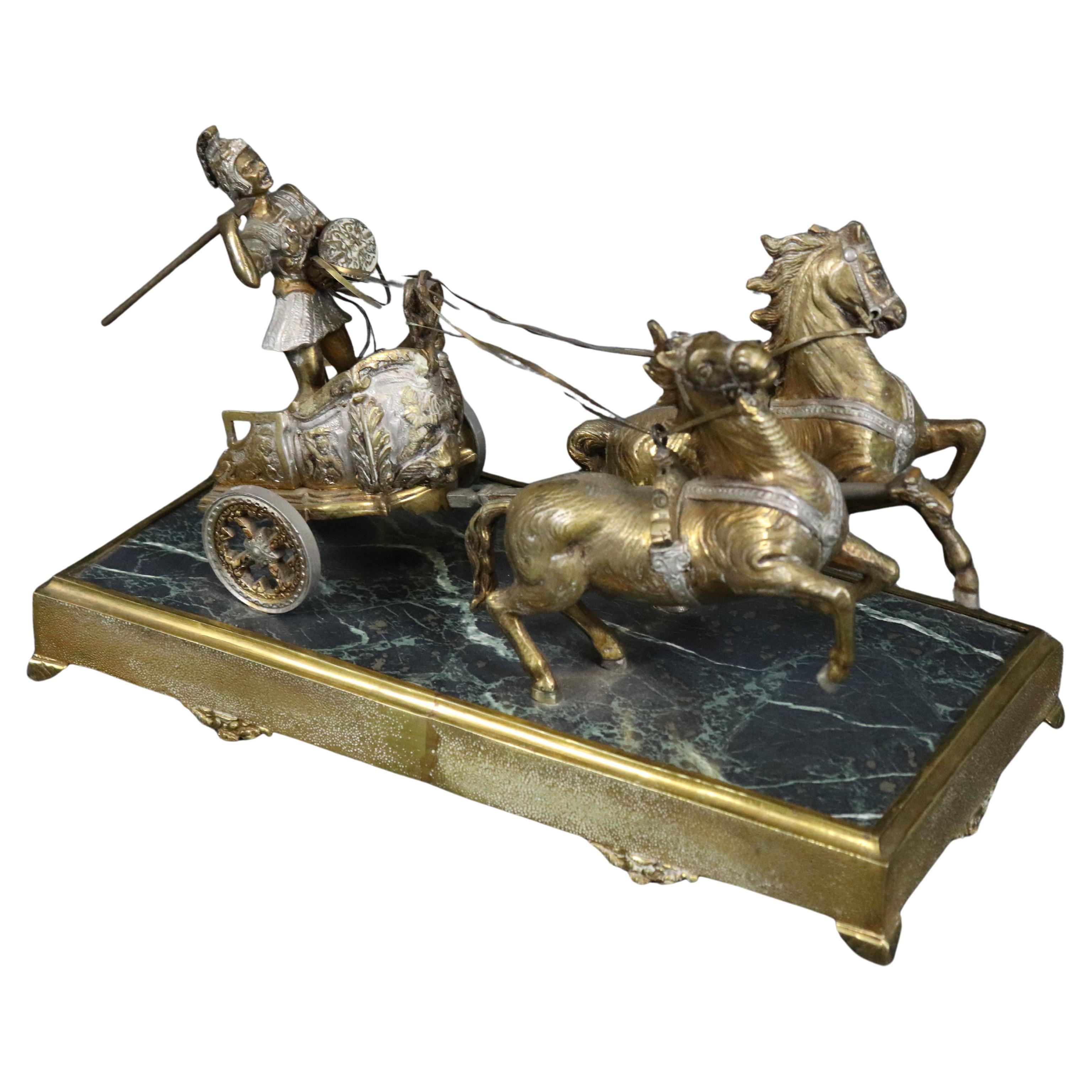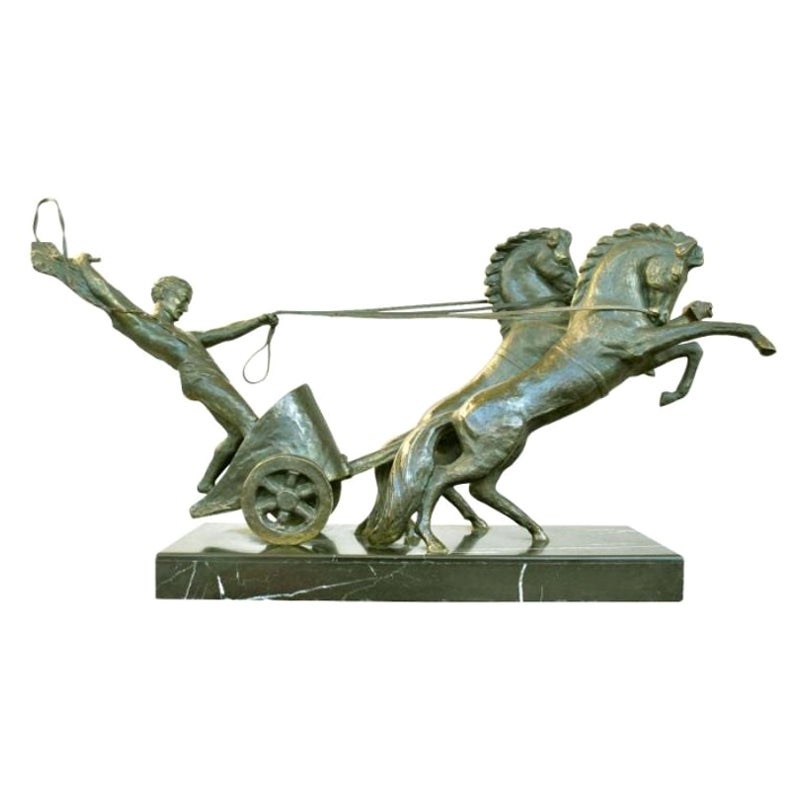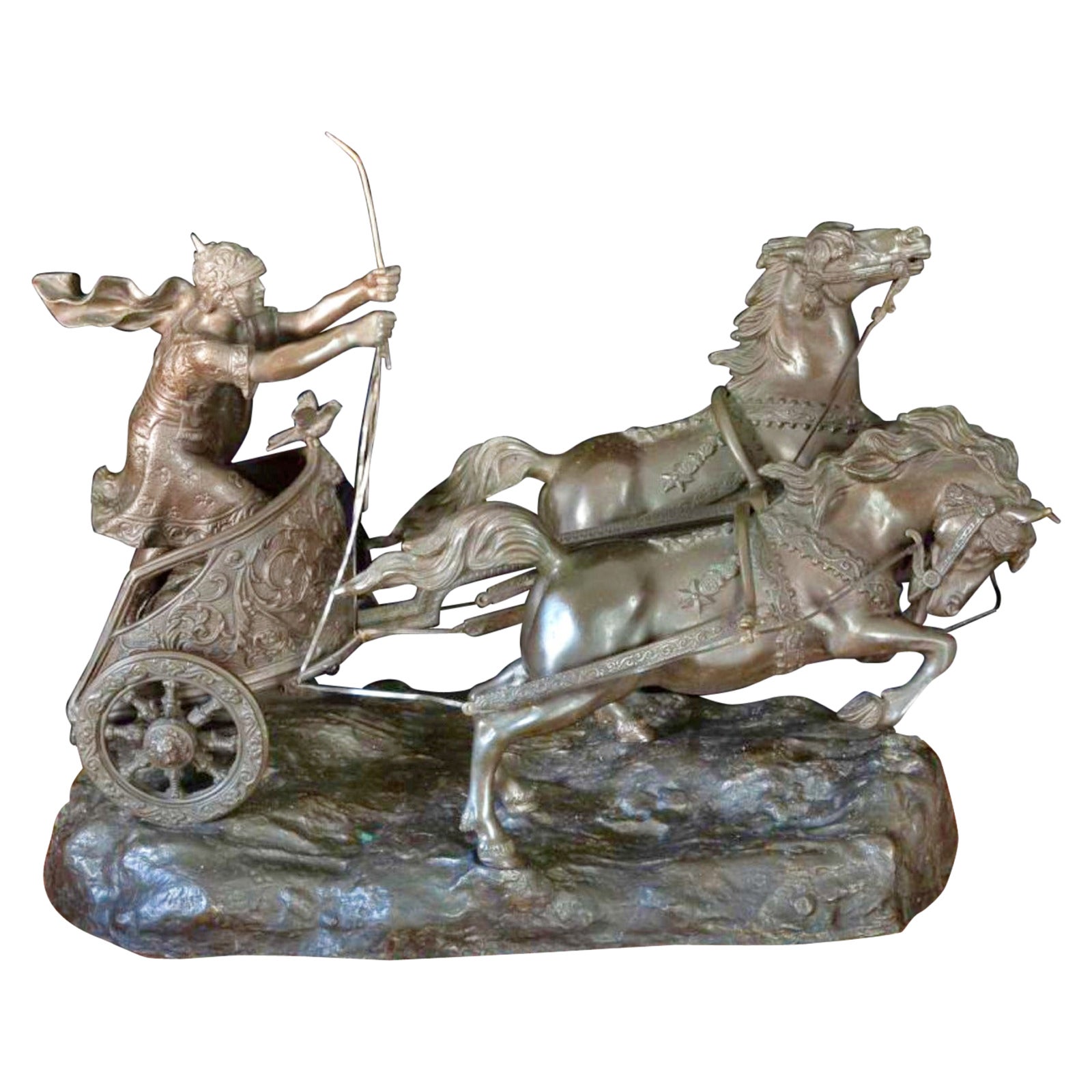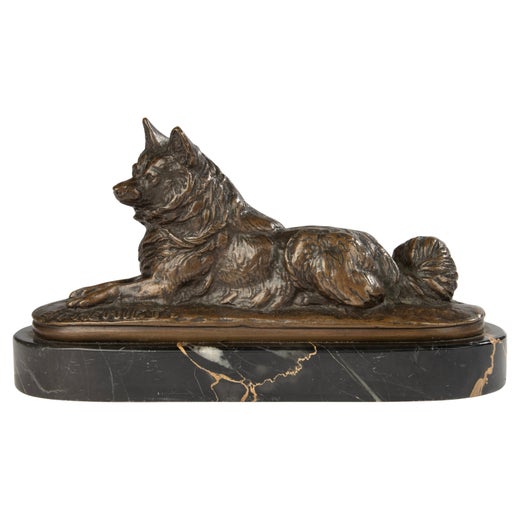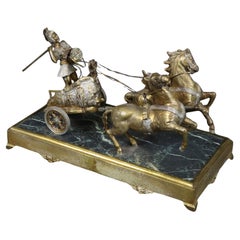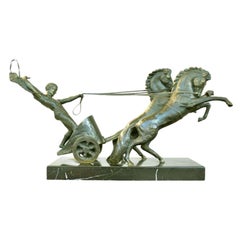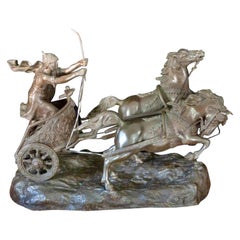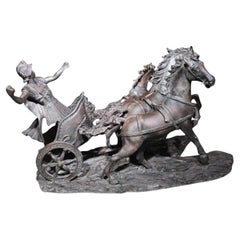Items Similar to Minerva driving her chariot
Want more images or videos?
Request additional images or videos from the seller
1 of 19
Emmanuel FremietMinerva driving her chariotcirca 1900
circa 1900
$20,471.17
£15,146.10
€17,000
CA$28,305.03
A$31,075.40
CHF 16,212.10
MX$376,055.55
NOK 203,193.51
SEK 191,461.71
DKK 129,438.48
About the Item
"Minerva driving her chariot"
by Emmanuel Fremiet (1824-1910)
Very beautiful group in bronze with old gilded patina
Cast by BARBEDIENNE
France
circa 1900
height : 54 cm
length : 54 cm
depth : 32 cm
Biography :
Emmanuel Fremiet (1824-1910) was the nephew and pupil of sculptor François Rude. Alongside his monumental works commissioned by the state, he was recognized as an excellent realistic animal sculptor. Emmanuel Fremiet devoted mainly to equestrian statues. He started as a scientific lithographer (osteology) and worked in the studio of painters from the morgue. In 1843 he sent to the Salon a "Gazelle" study preluding a prolific output. His "wounded Bear" and "injured Dog" acquired by the State for the Musée du Luxembourg in Paris in 1850. During the 1850s, Fremiet produced works on the theme of Napoleon III. He exposed bronzes representing bassets of Napoleon III, "Ravageot and Ravagode" at the Salon of 1853. From 1855 to 1859, he performed a series of military subject statuettes for the emperor. He realized the Napoleon Monument in 1868 and the one of Louis of Orleans in 1869 (Château de Pierrefonds). In 1874, Emmanuel Fremiet designed the first equestrian monument of Joan of Arc, erected on the Pyramids square in Paris, replaced with another version in 1900. During this period, he also performed "Pan and cubs" (Paris, Musée d'Orsay).
At the end of the nineteenth century, Fremiet was inspired by a new theme : the confrontation between man and beast. The news reported by the newspaper The Times that in 1880, in a Gabonese village, a bewildered and angry gorilla allegedly abducted and molested a woman, after having destroyed shacks. Moreover, the stories of explorers like Alfred Russel Wallace made articles and engravings for the newspapers, illustrating the attack of a Malaysian tracker by an orangutan. This theme inspired Fremiet several major works. "The Gorilla kidnapping a black woman" was initially refused by the jury of the Salon of 1859 and then presented behind a curtain. Another version received a medal of honor at the Salon of the Society of French Artists in 1887. This work, famous in his time, however rose a scandal because of it subject : it represented a gorilla kidnapping a naked woman, allegedly with a intent to rape her, what excited public curiosity. In the same vein, and even more remarkable was the "Orangutan strangling a wild Borneo" (1895), commissioned by the National Museum of Natural History in Paris, inspired by the stories of Wallace reported with many exaggerations by The Times. This time the animal is a male, and throttling the "wild man", he performs an act as impossible, physically and ethologically that the rape of a woman by a gorilla. But art works, and generations of visitors of the Museum where it was exposed, were horrified by the force emanating from the work.
In 1893, the Fremiet made the Velázquez Monument for the garden of the Colonnade of the Louvre Palace in Paris, and then in 1897, the statue of St. Michael slaying the dragon for the abbey of Mont Saint-Michel. Fremiet was elected member of the Academy of Fine Arts in 1892 and succeeded Antoine-Louis Barye as a teacher for Animal Drawing at the National Museum of Natural History in Paris. He was a member of the French Artists Society until 1908.
- Creator:Emmanuel Fremiet (1824-1910, French)
- Creation Year:circa 1900
- Dimensions:Height: 27.56 in (70 cm)Width: 20.87 in (53 cm)Depth: 12.6 in (32 cm)
- Medium:
- Movement & Style:
- Period:
- Condition:
- Gallery Location:PARIS, FR
- Reference Number:Seller: N.65861stDibs: LU2514213423342
Emmanuel Fremiet
Emmanuel Frémiet was born in Paris, France in 1824 and was brought into an upper middle-class family that had very close ties to the world of art. His family was filled with great artists and this included his Cousin Sophie who married a famous sculptor called Francois Rude. Emmanuel’s mother was also an accomplished artist who constantly encouraged him and brought him up into the world of art. At the age of five, he was already was receiving formal training in art in a private school. The start at a young age meant he was able to be accepted at the spectacular Ecole des Arts Decoratifs School at the age of sixteen. Throughout this period he learned everything he needed to then become employed by Werner as his head lithographer within a year, whose duties were to prepare drawings of both animals and men. After a long period of convincing by Sophie and Emmanuel, Francois Rude took Emmanuel as a pupil in his studio to further his learning in modeling and sculpture work. Throughout his young life, he spent a lot of time in zoological gardens and participated in dissections of any animals which had passed away during this time. By the age of seven, he had been exposed to a wide range of different wild animals. To further Emmanuel’s path in art, he was appointed the successor of Antoine Louis Barye as Professor of Drawing after Antoine’s death in 1875. With this new position and like many other great sculptors, he spent a lot of time studying and drawing at the morgue and even went to various embalmers across Paris. This was all of his training to give him the exact measurements and to be able to reproduce the muscle and bone structure of the many men and animals that he witnessed. His first sculpture was exhibited in the Paris Salon in 1843 when he was nineteen and he continued to exhibit his magnificent sculptures for the rest of his life at the Salon. He was even awarded various medals and awards from many of his pieces. As he began with the bronze sculptures, he made many small animal bronzes with very fine detail which are nowadays highly sought after by collectors and museums alike. There were many sculptors during this time that crafted pieces in which showed a cruel nature, but Emmanuel was known for the soft and gentle pieces of work which often were amusing. At the age of twenty-five, he was to receive more commissions than any other sculptor before or during his time. It became near impossible to be able to walk the streets without seeing one of Emmanuel’s many smaller bronze sculptures. This amazing sculptor continued crafting works, but also proceeded to train new sculptors, taking on near twenty pupils each time. Unfortunately, this great sculptor passed away in 1910.
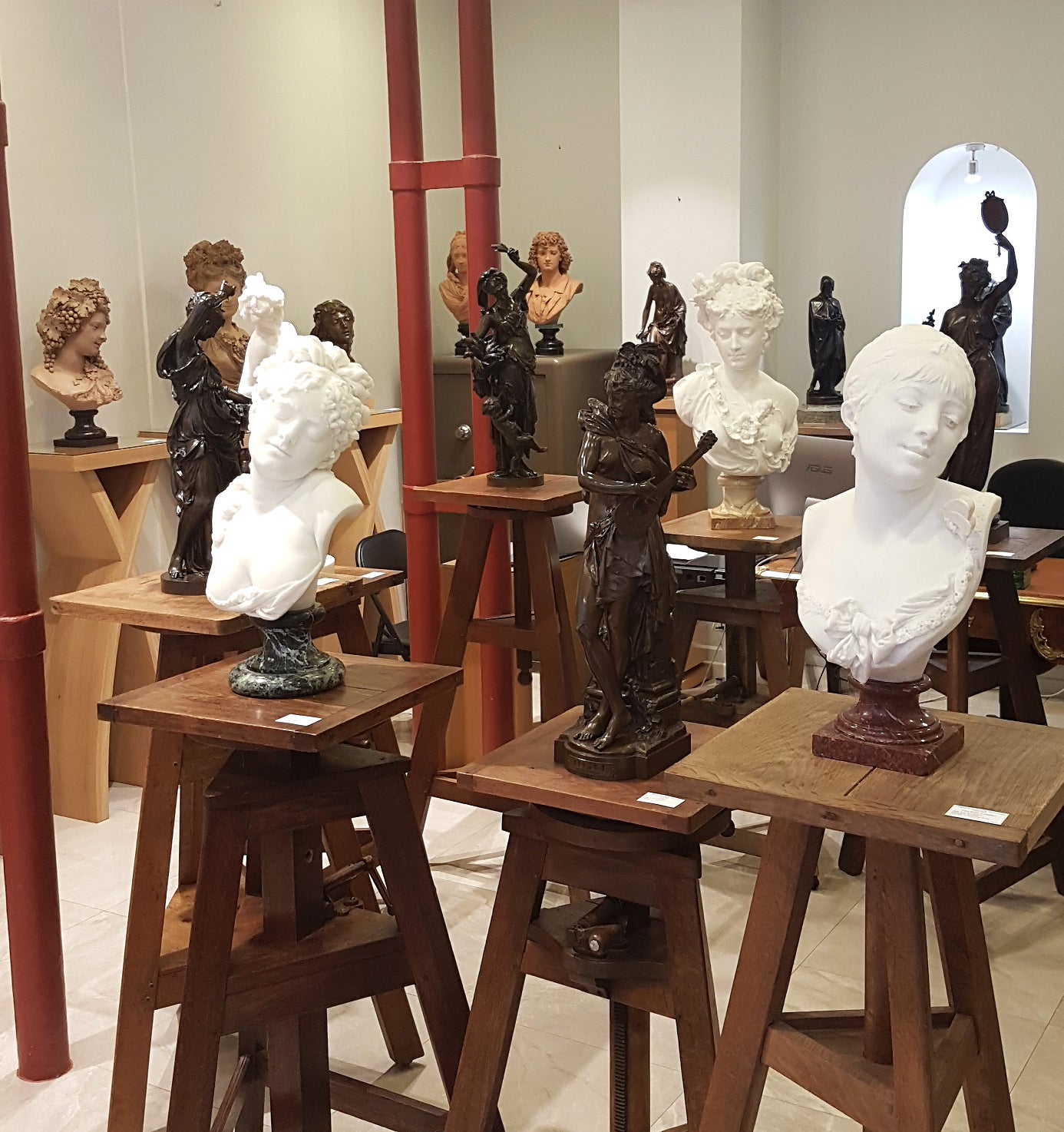
About the Seller
5.0
Recognized Seller
These prestigious sellers are industry leaders and represent the highest echelon for item quality and design.
Established in 1992
1stDibs seller since 2023
10 sales on 1stDibs
Typical response time: 9 hours
- ShippingRetrieving quote...Shipping from: PARIS, France
- Return Policy
Authenticity Guarantee
In the unlikely event there’s an issue with an item’s authenticity, contact us within 1 year for a full refund. DetailsMoney-Back Guarantee
If your item is not as described, is damaged in transit, or does not arrive, contact us within 7 days for a full refund. Details24-Hour Cancellation
You have a 24-hour grace period in which to reconsider your purchase, with no questions asked.Vetted Professional Sellers
Our world-class sellers must adhere to strict standards for service and quality, maintaining the integrity of our listings.Price-Match Guarantee
If you find that a seller listed the same item for a lower price elsewhere, we’ll match it.Trusted Global Delivery
Our best-in-class carrier network provides specialized shipping options worldwide, including custom delivery.More From This Seller
View AllRoman driver on his chariot
By Emmanuel Fremiet
Located in PARIS, FR
Roman driver on his chariot
by Emmanuel Fremiet (1824-1910)
Bronze group with its original nuanced green patina
signed on the base " E. Fremiet "
cast by More
France
circa 1880
hei...
Category
Late 19th Century French School Figurative Sculptures
Materials
Bronze
Equestrian Louis of Orleans
By Emmanuel Fremiet
Located in PARIS, FR
Equestrian Louis of Orleans
by Emmanuel FREMIET (1824-1910)
A very fine bronze equestrian group with a gilded patina
Signed " E. Fremiet " on the base
Cast by " F. Barbedienne Fond...
Category
Late 19th Century French School Figurative Sculptures
Materials
Bronze
Equestrian Joan of Arc
By Emmanuel Fremiet
Located in PARIS, FR
Equestrian Joan of Arc
by Emmanuel FREMIET (1824-1910)
A very fine bronze equestrian group with a greenish dark brown patina
signed " Fremiet " on the base
cast by " F. Barbedienne...
Category
Late 19th Century French School Figurative Sculptures
Materials
Bronze
Centaur abducting a woman
By Aimé-Jules Dalou
Located in PARIS, FR
Centaur abducting a woman
by Aimé-Jules DALOU (1838-1902)
A bronze group sculpture with a dark brown patina
Signed on the base "Dalou"
Cast by "A.A. Hébrard" (with the foundry sta...
Category
Late 19th Century French School Figurative Sculptures
Materials
Bronze
Saint Hubert's Day, 1520
By Emmanuel Fremiet
Located in PARIS, FR
Emmanuel FREMIET (1824-1910)
" La Saint Hubert, 1520 "
A very fine bronze equestrian group with a gilded patina
Titled to the front "La St Hubert, 1520"
signed "E. Fremiet" on the ...
Category
Late 19th Century French School Figurative Sculptures
Materials
Bronze
Tartar warrior stopping his horse
By Antoine-Louis Barye
Located in PARIS, FR
Tartar warrior stopping his horse
by Antoine-louis BARYE (1796-1875)
Equestrian group in bronze with a nuanced dark greenish brown patina
any cast mark
old edition cast
France
cir...
Category
Late 19th Century French School Figurative Sculptures
Materials
Bronze
You May Also Like
Stunning Bronze and Marble Roman Soldier on Chariot with Horses
Located in Swedesboro, NJ
This Stunning Bronze and Marble Roman Soldier on Chariot with Horses is a magnificent representation of ancient Roman history captured in exquisite detail. The sculpture showcases a ...
Category
Vintage 1930s European Neoclassical Figurative Sculptures
Materials
Breccia Marble, Bronze
Bronze Representing Roman Chariot Marble Base by Michel Decoux
By Michel Decoux
Located in Marseille, FR
Neoclassical bronze representing a Roman Chariot launched at full gallop mounted on a marble terrace. by Michel Decoux. Dimension: height 54 cm, total length 96 cm for a depth of 25 ...
Category
Vintage 1930s Figurative Sculptures
Materials
Bronze
Roman Bronze Sculpture Depicts Roman Chariot 19th Century
Located in Madrid, ES
Roman bronze sculpture
Depicts Roman Chariot
19th century
Measures: cm. 33 × 66 H. 50
Good conditions.
Category
Antique 19th Century Italian Baroque Figurative Sculptures
Materials
Bronze
Large Bronze Sculpture of Roman Chariot – 120 cm
Located in Madrid, ES
This impressive bronze sculpture, depicting a Roman chariot drawn by four horses, is an exceptional work of art from early 20th-century Italy. Standing at a remarkable 120 cm in heig...
Category
Vintage 1920s Figurative Sculptures
Materials
Bronze
19th Century Bronze Statue of Aurora on Her Chariot. Aug. Moreau
By August Moreau
Located in Brighton, Sussex
The Chariot of Aurora. Aurora the goddess of dawn shown in her chariot, accompanied by the hours and heralded by Apollo; Gilded and patinated.
Signed; Auguste Moreau (1834-1917) was a famous...
Category
Antique 19th Century French Classical Greek Figurative Sculptures
Materials
Bronze
Rosenthal figure "Amazon riding a horse" by Anton Grafth
By Anton Grath
Located in Autonomous City Buenos Aires, CABA
Rosenthal Figure "Amazon Riding a Horse" by Anton Grafth
Beautiful and striking porcelain sculpture depicting a nude woman riding a horse. The horse is rearing on its hind legs, the ...
Category
20th Century German Art Deco Figurative Sculptures
Materials
Porcelain
More Ways To Browse
Antique Minerva
Antique Malaysia
Joan Of Arc
Bronze Statue Of Man And Woman
Antique Joan Of Arc
Antique St Michael
Fremiet Emmanuel
Francois Rude
Fremiet Bronze
St Michael And The Dragon
Glenna Goodacre
Hans Harry Liebmann
Hayward Oubre
Henri Louis Bouchard
Italian Bronze Sculpture Venus Green
Jack Of The Dust
Jade Horse Carriage
James Muir Bronzes
